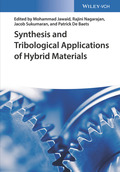Synthesis and Tribological Applications of Hybrid Materials

1. Auflage Oktober 2018
248 Seiten, Hardcover
56 Abbildungen (31 Farbabbildungen)
Monographie
Jetzt kaufen
Preis: 119,00 €
Preis inkl. MwSt, zzgl. Versand
Euro-Preise für Wiley-VCH- und Ernst & Sohn-Titel sind nur für Deutschland gültig. In EU-Ländern gilt die lokale Mehrwertsteuer. Portokosten werden berechnet.
- Gedruckte Ausgabe vergriffen -
In-depth knowledge on tribological applications of hybrid composites
Synthesis and Tribological Applications of Hybrid Materials provides a comprehensive overview of tribological properties of hybrid composites. The book offers an understanding of the processes, materials, techniques and mechanisms related to the tribological concepts and includes information on the most recent developments in the field. With contributions from an international panel of experts, the book discusses the synthesis and characterization of hybrid materials, as well as their applications in biotechnological and biomedical fields.
The book covers a wide-range of versatile topics such as: Tribological assessment on accelerated aging bones in polymeric condition; Nano fracture and wear testing on natural bones; Tribological behaviour of glass fiber with fillers reinforced hybrid polymer composites and jute/glass hybrid composites; Wear properties of glass fiber hybrid, and acid- and silane-modified CNT filled hybrid glass/kenaf epoxy composites; Hybrid natural fibre composites as a friction material; and much more. This important resource:
-Discusses recent advancements in the field of tribology and hybrid materials
-Offers a guide for professionals in the fields of materials science, mechanical engineering, biomaterials, chemistry, physics and nanotechnology
-Integrates theory, synthesis and properties of nybrid materals as well as their applications
-Offers an outlook to the future of this burgeoning technology
Written for materials scientists, surface chemists, bioengineers, mechanical engineers, engineering scientists and chemical industry professionals, Synthesis and Tribological Applications of Hybrid Materials is a comprehensive resource that explores the most recent developments in the field.
Mechanical and Tribological Behaviour of Polymeric Hybrid Composites Based on Natural Fibres
Wear Characteristics of Jute/Glass Fiber Hybrid Composite,
Friction and Wear Behaviors of Cotton/Sisal Natural Fiber Reinforced Hybrid Laminated Composites.
Friction and Wear Characteristics of Sugar Palm Based Hybrid Composites
Effect of Tri-Layered Natural Fiber Hybrid Composited on Dry Sliding Fiction
Hybrid Natural Fibre Composites for Bio-Medical Applications
Hybrid Natural Fibre Composites as a Friction Material
Self-Lubricating Capabilities of Hybrid Natural Fibre Composites
Wear Properties of Nano/Kenaf Filled Epoxy Hybrid Composites
Development of Abaca Reinforced Polyester Hybrid Composites for Hydrophobic and Outdoor Structural Applications
Mechanical and Tribological Properties of Wood Apple Shell Reinforced Epoxy Composites
Rajini Nagarajan, PhD, is associate professor in the Department of Mechanical Engineering, Kalasalingam University, TamilNadu, India.
Jacob Sukumaran, PhD, is a researcher at the Soete Laboratory at Ghent University.
Patrick De Baets is a professor in the Department of Electrical Energy, Systems and Automation at Ghent University.


